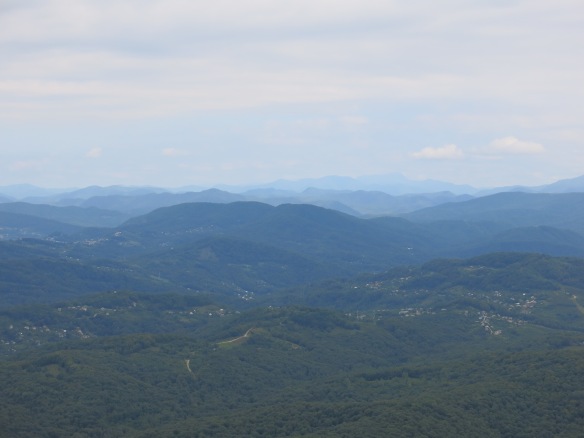
Caucasus Mountains outside of Sochi. The outdoor Olympic events will be held in these mountains. This past summer our ship had a port of call in Sochi, Russia, site of next month’s 2014 Winter Olympics. Disembarking, the first thing I noticed about Sochi was…palm trees. And the warm, humid weather, despite an overcast sky.
I did a quick fact check on Sochi. Per Wikipedia, Sochi is “one of the very few places in Russia with a subtropical climate, with warm to hot summers and mild winters.” Sochi obviously isn’t called the “Russian Riviera” because of its snowfall.
Okaaay. So, with “mild winters,” where’s the snow? Is there any? I mean, I grew up in tropical and sub-tropical climes, and snow…well…the closest we got to snow was ice cream, which melted pretty damn fast in that weather. “Mild” winters to me just don’t conjure up visions of snowflakes and Frosty the Snowman.
Reading on, I found that Sochi is, in euphemistic terms, “a domestic destination,” meaning this largest of Russia’s summer resorts, with its 4 million visitors every year entices – overwhelmingly – native Russians. Wikitravel notes, “only three percent of this visitors’ crowd are international travelers.” The website continues to paint a rather unattractive picture of Sochi as a travel destination, noting that the city is “somewhat lacking in appropriate international infrastructure and having the same language barrier most regional centers of Russia do.” Sochi is also referred to as a “one lane town.”
That the city has a poor infrastructure was readily admitted by our guide. Not that we needed verbal confirmation. Taking in our surroundings as we crawled through downtown Sochi’s jam-packed traffic in our mini-van, I noticed a lot of residential buildings going up, streets clogged with construction equipment and debris – as well as mired vehicles with angry drivers. I did not see any stadium-like structures, nary a one in sight. Some of us started nudging others, raising eyebrows and shoulders in question. The guide prattled on about Sochi’s tourist sites, its growth, its modern shops, casinos. Everything except the Olympics just six months away.
Not to be deterred, some of us, after exchanging whispered astonishments, girded our loins and asked our guide, oh so casually, “So how’s it going, preparing for the Olympics? Does Sochi actually get snow?”
The guide admitted that the construction of the Olympic villages and sports facilities was behind schedule, and that the train line to the ski resort in the mountains, about 30 miles away, was nowhere near completion. Gesturing at the unfinished buildings and vehicular gridlock we’d sat in for several minutes, she said, “All this is for the Olympics,” and noted that a lot would have to be “cleaned up” before the Olympics began in six months. Her next words left us agape: “But they’re already making snow. There will be plenty of snow by February.”
What? The site of the Winter Olympics has to manufacture snow? Doesn’t look promising, boys and girls.
So Why Sochi?
So just how did Sochi get picked as the site of the Winter Olympics? In two previous attempts at grabbing the crown, Sochi had been turned down by the International Olympic Committee (IOC) specifically because of its lack of infrastructure. This time around, the IOC Evaluation Committee didn’t seem to have an issue with that deficiency when they visited this humid, subtropical capital.
Jean-Claude Killy, France’s 1968 gold medalist in skiing and member of the IOC Evaluation Committee admitted, after the 2007 site visit, “It’s probably the most challenging Olympics ever, as far as what has to be built to deliver these Olympic Games. We have a lot of work to do together.”
The answer to “Why Sochi?” is probably a combination of politics and pressure from Russian President Vladimir Putin. An ardent skier, Putin may not be a capitalist with a capital “C” but he certainly knows how to capitalize on his goals while applying political muscle and wealthy connections. (More on his “connections” later.)
In reality, the Caucasus Mountain range, looming on the horizon northeast of Sochi, does get a fair amount of winter snow. Krasnaya Polyana, the mountain region at 7,600 feet where the outdoor events will be staged, has had basic skiing facilities for nearly 10 years. And per skiers who’ve made the trek to this formerly isolated and under-developed ski area, Krasnaya Polyana has some of the best skiing in Europe. However, infrastructure remains the bugaboo in this wintry tale. Krasnaya is about 30 miles away from the city of Sochi on the coast. The two are connected only by a single roadway that is quite obviously not able to handle the Olympian sized traffic that will descend on it. Not to worry, the Russians are building hundreds of miles of new roads and rails, including a high-speed train to connect Sochi and Krasnaya. Let’s just hope it all gets finished in time to be of use.
And then there is the cost. Certainly Putin was willing to shell out the rubles for the honor of hosting the Winter Olympics, but the price tag has exceeded all expectations. Russia’s initial estimate of the cost of preparing the Sochi area for the games was $12 billion. At the time the IOC awarded Russia the honor of the Winter Olympics, Krasnaya Polyana had only four ski lifts. To build this “resort” up to Olympic standards for all the skiing, ski jumping, snowboarding, luge and other events has so far cost $2.6 billion.
The road from Adler, the site of the coastal Olympic Village, to the mountain Olympic Village at Krasnaya Polyana cost about $8.7 billion, once you add up the costs for the roads, railways, bridges and tunnels necessary to transport people and equipment to and fro. The “Ice Palace,” as our guide called it, at Adler, about 15 miles south of cental Sochi, cost a mere $302.9 million to build – what a bargain – and will house the “indoor” winter sports, mostly skating.
All told, the Russians thus far have poured over $51 billion into preparing Sochi and the surrounding areas for these Olympics, making it the most expensive Olympics to date. By contrast, the 2010 Winter Olympics in Vancouver, Canada, cost $7 billion, and the over-the-top Summer Olympics in Beijing in ’08 cost a whopping $40 billion.
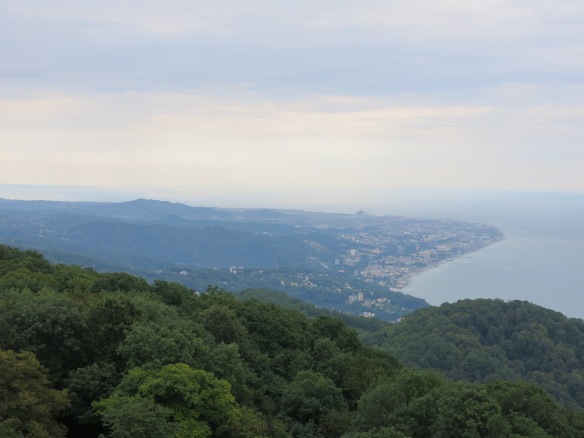
Looking south of central Sochi to Adler, where the indoor Olympic events will take place
Unfortunately, the story of the making of the 2014 Winter Olympics doesn’t end with questions of sufficient snow and infrastructure. A major player in these political and construction games has been the so-called Russian Mafia, some very bad boys in the organized crime fraternity. The path to Sochi is littered with bodies, as different crime bosses have bumped off rivals for a share of the Olympic pie. And, of course, there are the kickbacks and graft, with not a few of Putin’s inner circle receiving lucrative contracts. According to an article in February’s Vanity Fair, the Sochi Internal Affairs department has been busily investigating “numerous” charges of criminal complaints having to do with kickbacks, graft and even stolen Olympic funds. Unsurprisingly, not one of these cases has made it to court.
What was the IOC thinking?
But wait! There’s more! Remember those two suicide terrorist bombings recently in Volvograd that killed 34 people? Just the tip of the iceberg, folks. Volvograd, formerly Stalingrad, is directly northeast of Sochi as the crow flies – right on the other side of the Caucasus Mountains. And in between are some pretty nasty Islamic insurgent groups who have trumpeted their goal of “disrupting” the Winter Olympics. Three hundred miles to the southeast of Sochi, the province of Dagestan “shootings of police and other officials have become a daily occurrence in the region.” And in between lies Georgia, whose post-Soviet relations with Russia have been rather militant for years.
So it’s no surprise that the U.S. State Department has issued one of its dire travel warnings, stating, that the “terminally unsafe areas of the country include Sochi and border areas near other Russian provinces.” “Terminally unsafe”? You’ve got to be kidding that we’re sending our best athletes there.
But, as Vanity Fair points out, “Russians do security well, and they do it all the way.” Ah. “Russian security.” (Not so fond memories of the Cold War inevitably spring to mind.) Part of the “security” plan is to close the borders with one of Russia’s more explosive neighbors, Georgia, to the east. The duma (Russia’s national legislative body) is expected to pass severe anti-terrorism legislation before the games open. Additionally, a tight security net will be set up around greater Sochi – which is 1300 sq. miles in size and extends 90 miles along the Black Sea coast, and drones will be patrolling the skies above. It will be interesting to see if the heightened level of “security” in the Olympic villages will quell the usual tsunami of athlete hook-ups which are as endemic to the games as medals.
And then, there’s the whole troubling issue of Russia’s very strong anti-gay sentiments – and laws. With plans on to have a “gay pride” parade on opening day of the Winter Olympics, it will be interesting to see Sochi’s — and Putin’s – reaction. Putin couldn’t do much about President Obama purposefully sending openly gay Olympic “ambassadors” to the games, but having a bunch of lawless, godless homosexuals marching the streets of Sochi and garnering world-wide attention may be a bit more than the diminutive Russian dictator – Oh! Sorry! – “president” will tolerate.
The Tourist Side of Sochi (Yes, there is one. Sort of.)
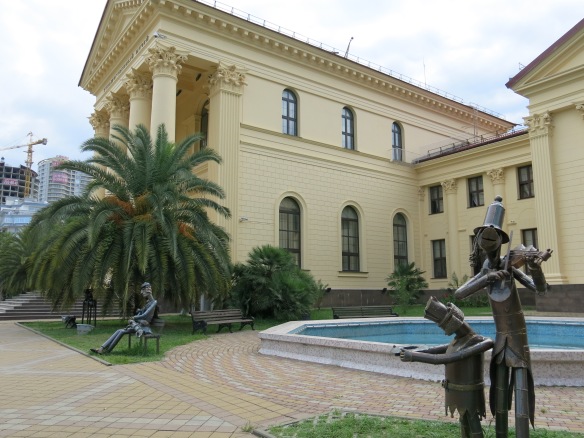
Sochi Art Museum.
Our guide took us on two long walks through Sochi, much to our delight as we were sick of sitting in traffic gridlock. In central, downtown Sochi stands the Art Museum, constructed in the late 1930’s in a neo-classical style. We didn’t enter the museum, just strolled through the gardens, admiring scattered sculptures. Michael decided to have a conversation with one of them.
The other walk was in Riviera Park, with beautiful tree-lined paths and walks. Many of the bushes were flowering, and the scene was quite peaceful after the traffic jams. At least until a Sochi babushka went after some of our group.
According to Michael, he and another guy in our group were trailing at the rear when a young woman and an old woman, walking together, passed us by. The old woman, as she passed and heard English being spoken, whipped around and marched at them, screaming in Russian and waving her fist. The younger woman, probably her granddaughter, quickly grabbed the older one and pulled her away, still grumbling. An interesting display of undying Cold War sentiment!

Stalin’s dacha
Stalin’s Dacha
Josef Stalin’s favorite summer resort was Sochi, so it’s no surprise that he had a dacha in the hills overlooking the resort. Painted green for camouflage on the treed hillside, the house would never win even a booby prize for either aesthetic or architectural design; I’ve seen more appealing boot camps. But it’s what Stalin called his home away from home. The interior was dimly lit, with heavy, blocky furniture, floor-to-ceiling drapes, and exuded a repressive feeling. However, the interior furnishings are just as they were in Stalin’s day, and include a wax figure of Stalin, seated at his desk. Interestingly, he kept a narrow, single bed by his desk in his office; perhaps he needed frequent cat naps. And I just couldn’t resist sneaking into the bathroom and snapping a photo of old Josef’s “throne.”
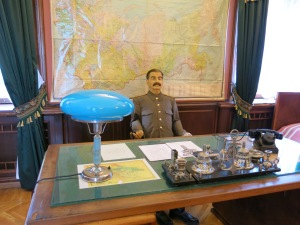
Stalin (wax figure) at his desk
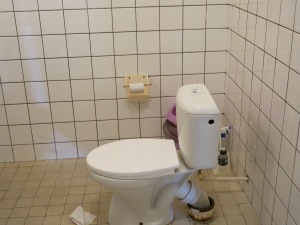
Stalin’s “throne”
Surprisingly, the house is used today as both a restaurant and guesthouse. People actually pay as much as 300 euros to spend the night in one of the guest bedrooms. That pronouncement from our guide received a few strange looks for sure. The dacha lacked any remote shreds of ambience.
Let the Games Begin
So, bottom line on Sochi: as a tourist destination, it didn’t do much for me. Maybe freezing Muscovites find the town delightful, but I’ll take a pass on returning. As for the Winter Olympics, I can only hope that the Russians are better at security than construction, for the sake of all the athletes, spectators and citizens of Sochi. No one wants another Munich. On the other hand, with bombings and shootings an everyday occurrence in the surrounding area, the odds of having at least one or two terrorism attempts seem high.
And as for snow? From what I’ve read, sufficient snow shouldn’t be a problem up in the mountains. But just in case, Putin’s got 700,000 tons of it stockpiled and ready to be dumped on the slopes. What I can’t figure out is how they’d apply it.
************************
Note: The opinions expressed in this blog are my own. I did considerable research on Sochi and the upcoming Winter Olympics.
![]()

Carol Barbier Rolnick grew up in Japan and Southeast Asia, traveling extensively as a child through Asia, the Mideast and Europe on family vacations. Travel has continued as a priority through raising kids and continuing into retirement, extending adventures through the Americas, southern Africa, Asia, and repeat trips throughout Europe. Carol and her husband, Michael spent four summers based in Utrecht, The Netherlands, which has become like a second home. They are (still) aiming towards Australia-New Zealand and Antarctica to round off their continental travels.








